Expenditures of the Aged
Social Security Bulletin, Vol. 67, No. 1, 2007 (released August 2007)
This article includes a short overview of existing research and reprints some of the charts available in the Expenditures of the Aged Chartbook. The goal of the chartbook is to improve the availability of statistics on expenditures of the aged. Data are based on the 2002 Consumer Expenditure Survey Public-Use File. Measures of standards of living, such as expenditures, help inform policymakers and researchers who are concerned about the adequacy of economic resources of the aged.
The author is with the Division of Economic Research, Office of Research, Evaluation, and Statistics, Office of Policy, Social Security Administration.
Contents of this publication are not copyrighted; any items may be reprinted, but citation of the Social Security Bulletin as the source is requested. The findings and conclusions presented in the Bulletin are those of the authors and do not necessarily represent the views of the Social Security Administration.
Summary and Overview
Policymakers and researchers are concerned about the adequacy of economic resources of the aged. Income tells part of the story with regard to adequacy, but it is also useful to seek out other measures of standards of living, such as expenditures. To improve the availability of statistics on expenditures of the aged, the Social Security Administration produced the Expenditures of the Aged Chartbook. The chartbook is based on data from the 2002 Consumer Expenditure Survey Public-Use File, sponsored by the Bureau of Labor Statistics. Both total expenditures and components of expenditures are examined to give policymakers and researchers a more comprehensive understanding of the expenditures of the aged. This article includes a short overview of existing research on the expenditures of the aged and examples of charts from the chartbook. The contents of the chartbook are displayed in Box 1. The chartbook is available on the Office of Policy Web site at http://www.socialsecurity.gov/policy.
Research on Expenditures of the Aged
The drop in expenditures after retirement is well documented. Hamermesh (1984) finds that preretirement expenditures are larger than expected income in retirement. Bernheim, Skinner, and Weinberg (1997) show that when workers retire, expenditures fall by 12 percent. Ameriks, Caplin, and Leahy (2002) and Hurd and Rohwedder (2003) find that retired households spend about 20 percent less than households in the years shortly before retirement.
Although expenditures are lower in retirement, it does not necessarily follow that standards of living and well-being are lower as well. It is possible that retirees expect to spend less and that well-being is maintained because they have more time to produce goods at home. Retirees may substitute housework, shopping, cooking, and home improvements for goods they would otherwise purchase at the store. In addition, retirees do not experience costs associated with working such as commuting.
Researchers have found evidence to support the theory that well-being for individuals in retirement is maintained at a lower expenditure level than it is for those active in the labor force. Ameriks, Caplin, and Leahy (2002) find that people expect expenditures in retirement to be lower by the same 10 percent to 20 percent difference that actual retirees experience. Hurd and Rohwedder (2003) show that retired men spend about 9 more hours a week on home production than they did while working. In addition, they find that workers expect retirement expenditures to be 20 percent lower, while retirees say their expenditures are from 12 percent to 17 percent lower than when they were working.
Data on Expenditures of the Aged
The chartbook is based on data from the 2002 Consumer Expenditure Survey Public-Use File. With records on 600 types of expenditures, the survey provides comprehensive data on the buying habits of consumers in the United States. The sample is representative of the total noninstitutionalized population in the United States. The Consumer Expenditure Survey program consists of two separate survey components, each with its own questionnaire and independent sample. The interview survey collects data on monthly expenditures; the diary survey collects weekly expenditures of frequently purchased items.
Expenditures in the survey are measured for the consumer unit (CU). The interview survey has an unweighted sample of 2,698 consumer units aged 55 or older, which are weighted to represent 37.7 million. A consumer unit can be members of a household who are legally related, a single person, or two or more people living together and sharing expenses. A CU's reference person is the CU member who primarily owns or rents the home. The characteristics of a CU, such as age, refer to those of the reference person. The average size of CUs, by age of the reference person, was 2.2 for CUs aged 55–64, 1.9 for those aged 65–74, and 1.5 for CUs aged 75 or older.
Expenditures of Consumer Units Aged 65 or Older
One section of the chartbook focuses on expenditures of consumer units aged 65 or older. Median expenditures for this age group were $19,476; mean expenditures, which were influenced by high-spending outliers, were $27, 902.
Charts in this section also look at per capita expenditures, shares of expenditures allocated to various components of spending, and distributions of expenditures by income quartile and earned income status. Chart 1, for example, shows the distribution of expenditures by earned income status. Almost three-fourths of CUs aged 65 or older had no earned income, which is defined as income from wages and salaries or from self-employment. Expenditures were different for CUs with earned income than for those with no earned income (Chart 1). Median expenditures for CUs aged 65 or older with no earned income were $17,012, compared with $28,469 for those with earned income.
Distribution of expenditures, by earned income status
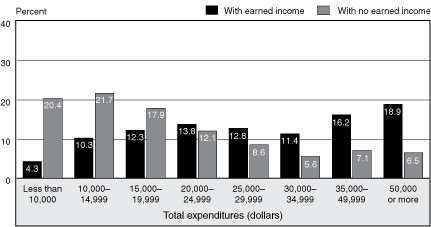
| Total expenditures (dollars) | With earned income |
With no earned income |
|---|---|---|
| Less than 10,000 | 4.3 | 20.4 |
| 10,000–14,999 | 10.3 | 21.7 |
| 15,000–19,999 | 12.3 | 17.9 |
| 20,000–24,999 | 13.8 | 12.1 |
| 25,000–29,999 | 12.8 | 8.6 |
| 30,000–34,999 | 11.4 | 5.6 |
| 35,000–49,999 | 16.2 | 7.1 |
| 50,000 or more | 18.9 | 6.5 |
Expenditures of Consumer Units, by Age
The Expenditures of the Aged Chartbook also contains many charts that compare expenditures for three age groups; the near aged (55–64) are compared with those aged 65–74 and 75 or older. Charts that present data by age group also show comparable data for those aged 65 or older as a whole; those data are given in either a table or a shaded bar that accompanies the charts.
Charts that consist of box plots show more of the underlying distribution of expenditures than do means or medians alone. The upper and lower edges of the box plots denote the 75th percentile and 25th percentile, respectively; the middle 50 percent of the data is a measure of variability. Chart 2 and the accompanying table, for example, show that total expenditures are lower for older age groups than for younger age groups. Median expenditures were 80 percent higher for CUs aged 55–64 ($30,584) than for those aged 75 or older ($16,878). Chart 2 also shows total expenditures by income quartile. The middle 50 percent of CUs aged 55–64 had expenditures between $18,881 and $50,005. The middle 50 percent of CUs aged 75 or older had expenditures between $11,016 and $26,356.
Total expenditures, by age
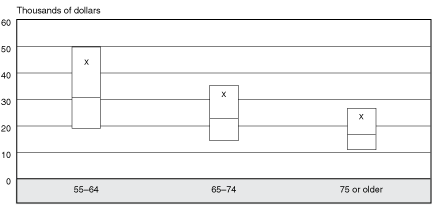
| Age group | 25th percentile | Median | 75th percentile | Mean |
|---|---|---|---|---|
| 55–64 | 18,881 | 30,584 | 50,005 | 44,037 |
| 65–74 | 14,358 | 22,636 | 35,324 | 32,003 |
| 75 or older | 11,016 | 16,878 | 26,356 | 23,597 |
| 65 or older | 12,516 | 19,476 | 30,916 | 27,902 |
| SOURCE: Expenditure percentiles are computed using the interview portion of the 2002 Consumer Expenditure Survey; means are computed using the interview and diary portions. | ||||
Examining expenditure amounts is useful, but it is also important to understand the components of expenditures: housing; food; out-of-pocket health care; transportation; apparel; entertainment; other expenditures; and travel expenditures, which reflect elements of spending for housing, food, transportation, and entertainment on out-of-town trips. Chart 3, for example, which presents the mean share of expenditures allocated to spending components, shows that housing accounted for the largest share of expenditures for all age groups.
Mean percentage allocated to components of expenditures, by age
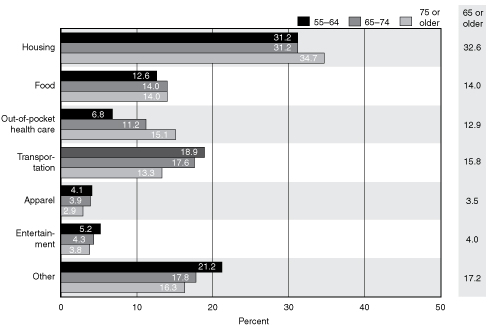
| Component | 55–64 | 65–74 | 75 or older | 65 or older |
|---|---|---|---|---|
| Housing | 31.2 | 31.2 | 34.7 | 32.6 |
| Food | 12.6 | 14.0 | 14.0 | 14.0 |
| Out-of-pocket health care | 6.8 | 11.2 | 15.1 | 12.9 |
| Transportation | 18.9 | 17.6 | 13.3 | 15.8 |
| Apparel | 4.1 | 3.9 | 2.9 | 3.5 |
| Entertainment | 5.2 | 4.3 | 3.8 | 4.0 |
| Other | 21.2 | 17.8 | 16.3 | 17.2 |
The mean share of expenditures allocated to some components of spending was similar across age groups. Housing accounted for 31 percent to 35 percent of expenditures, and food accounted for 13 percent to 14 percent. Apparel and entertainment represented a smaller percentage of spending, ranging from 3 percent to 5 percent of expenditures.
The share of spending on other components varied by age group. CUs aged 75 or older allocated 15 percent of expenditures to out-of-pocket health care compared with 7 percent for those aged 55–64. Compared with CUs aged 55–64, those aged 75 or older allocated 32 percent less of their expenditures to transportation (13 percent compared with 19 percent) and 24 percent less to other expenditures (16 percent compared with 21 percent); the category of other expenditures includes alcohol, personal care, reading material, education, tobacco, miscellaneous items, cash contributions to persons or organizations outside the consumer unit, personal insurance, pension contributions, and Social Security payroll taxes.
Additional charts focus on a specific component of expenditures. The underlying distributions of spending for components are displayed in charts using box plots. In addition, each of those components has a chart that shows an aspect specific to that component. Chart 4 and Chart 5, for example, show component-specific expenditures related to housing: housing tenure (the family's principal place of residence during the survey); and the share of expenditures allocated to housing, by housing tenure and age. About 80 percent of consumer units in all age groups owned a home, and most CUs aged 65–74 and 75 or older owned a home without a mortgage (Chart 4). Homeowners aged 55–64 were about as likely to have a mortgage as to not have a mortgage (about 40 percent each). Homeowners aged 65–74 were twice as likely not to have a mortgage (58 percent compared with 26 percent), and homeowners aged 75 or older were approximately seven times more likely not to have a mortgage (67 percent compared with 9 percent). The mean percentage of total expenditures allocated to housing (Chart 5) was lowest for homeowners without a mortgage (25 percent to 31 percent) and highest for CUs who rent (37 percent to 45 percent).
Distribution of consumer units, by housing tenure and age
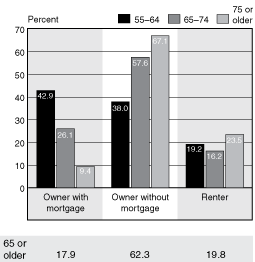
| Housing tenure | 55–64 | 65–74 | 75 or older | 65 or older |
|---|---|---|---|---|
| Owner with mortgage | 42.9 | 26.1 | 9.4 | 17.9 |
| Owner without mortgage | 38.0 | 57.6 | 67.1 | 62.3 |
| Renter | 19.2 | 16.2 | 23.5 | 19.8 |
Mean percentage allocated to housing expenditures, by housing tenure and age
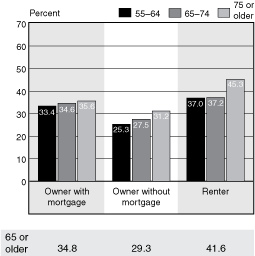
| Housing tenure | 55–64 | 65–74 | 75 or older | 65 or older |
|---|---|---|---|---|
| Owner with mortgage | 33.4 | 34.6 | 35.6 | 34.8 |
| Owner without mortgage | 25.3 | 27.5 | 31.2 | 29.3 |
| Renter | 37.0 | 37.2 | 45.3 | 41.6 |
Chart 6 is another example of a component-specific chart. It shows the percentage of consumer units, by age group, that allocated 95 percent or more of their food expenditures to food prepared and eaten at home. Older age groups allocated a larger share of food expenditures to this category than did younger age groups. CUs aged 75 or older were about twice as likely to allocate 95 percent or more of their food expenditures to food prepared and eaten at home than were CUs aged 55–64 (40 percent compared with 22 percent). The average percentage of food expenditures allocated to food prepared and eaten at home (not shown in Chart 6) was 56 percent for CUs aged 55–64, 64 percent for CUs aged 65–74, and 67 percent for CUs aged 75 or older.
Share of consumer units spending 95 percent or more of their food expenditures on food prepared and eaten at home, by age
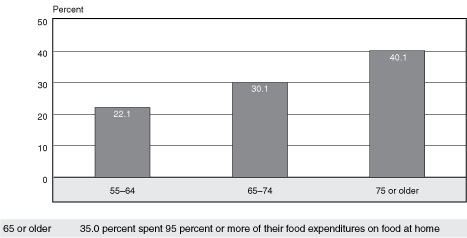
| Age group | Percent |
|---|---|
| 55–64 | 22.1 |
| 65–74 | 30.1 |
| 75 or older | 40.1 |
| 65 or older | 35.0 |
References
Ameriks, John, Andrew Caplin, and John Leahy. 2002. Retirement consumption: Insights from a survey. NBER Working Paper No. 8735, National Bureau of Economic Research, Cambridge, MA (January).
Bernheim, Douglas, Jonathan Skinner, and Steven Weinberg. 1997. What accounts for the variation in retirement among U.S. households? NBER Working Paper No. 6227, National Bureau of Economic Research, Cambridge, MA (October).
Hamermesh, Daniel S. 1984. Consumption during retirement: The missing link in the life-cycle. Review of Economics and Statistics 66(1): 1–7.
Hurd, Michael, and Susan Rohwedder. 2003. The retirement-consumption puzzle: Anticipated and actual declines in spending at retirement. RAND Labor and Population Program Working Paper Series No. 03-12, Santa Monica, CA (March).